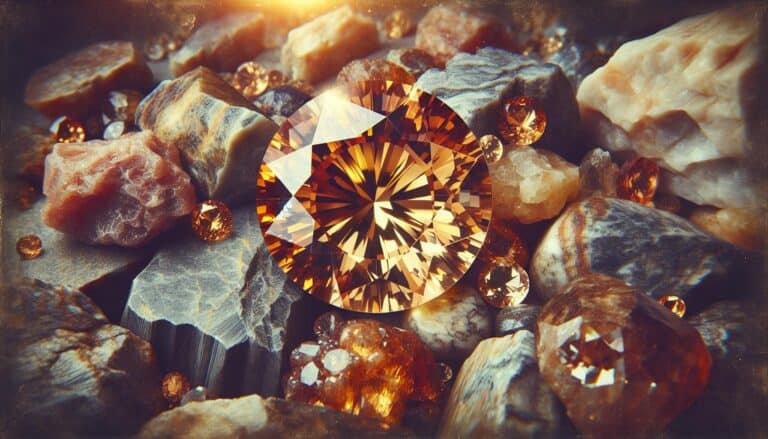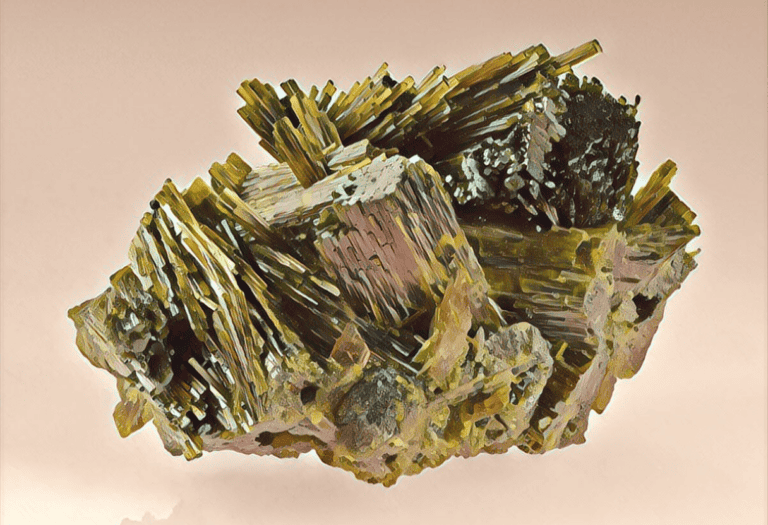Ever wondered where to uncover geological treasures in Rhode Island?
You’re in luck! The Ocean State may be small, but it’s packed with hidden gems just waiting for you to discover. From the sparkling shores to the craggy cliffs, rockhounding opportunities abound.
You’ll be amazed at what you can find: quartz crystals, fossilized plants, and even the state’s official rock, Cumberlandite. Whether you’re a seasoned rockhound or just starting out, Rhode Island’s diverse landscapes offer a unique adventure.
Get ready to explore the top spots where nature’s wonders are yours for the taking.
Rockhounding in Rhode Island offers unique finds like quartz crystals, fossilized plants, and Cumberlandite. Key locations include Arcadia Management Area for quartz and garnets, Misquamicut State Beach for fossilized plants, and Diamond Hill for amethyst. Adhere to safety and legal guidelines for a rewarding experience.
Rhode Island Rockhounding Locations
Whether you’re a seasoned expert or just starting out, Rhode Island offers a variety of rockhounding locations that cater to all levels of experience. Each site presents a unique set of treasures waiting for you to unearth.
Arcadia Management Area
Your first stop is the Arcadia Management Area. Quartz crystals and garnets glisten among the diverse geological formations here. The area’s vastness means you’ll have plenty of space to enjoy the hunt without feeling crowded.
- Cumberlandite: The state’s official rock is commonly found in this area.
- Field trips: Consider joining a group led by a local geology enthusiast for deeper insights.
Misquamicut State Beach
Stroll along the shores of Misquamicut State Beach where the ocean’s natural sorting action brings fossilized plants and petrified wood to your feet. Early mornings or after stormy weather are the best times to visit, when the tides churn up new finds.
Diamond Hill
At Diamond Hill, amethyst and smoky quartz are among the coveted finds. The hill’s name itself hints at the treasures you might stumble upon. Remember to bring your rock hammer and safety goggles, as you’ll be chipping away like a true rockhound.
Safety Tips for Rockhounding:
- Always wear protective gear while mining.
- Be mindful of the environment and adhere to local regulations.
- Research the area beforehand—knowing the terrain can lead to a more fruitful search.
By exploring these sites, you’re not only partaking in a thrilling pastime but also connecting with Rhode Island’s rich geological heritage. Each location yields distinctive specimens that tell the story of the region’s past. Embrace the adventure as you search, dig, and discover what Rhode Island’s soil has to offer.
What Gemstones are Found in Rhode Island?

While exploring the scenic terrains of Rhode Island, you’re likely to stumble upon a variety of intriguing gemstones. Rhode Island, often nicknamed the Ocean State, might be small, but it’s a treasure trove for rockhounds looking for precious finds.
One of the most sought-after gemstones in the region is amethyst. This purple quartz variant, best known for its vibrant hue and crystal clarity, is predominantly found in areas like Diamond Hill. Here, amethyst crystals can range from light lilac shades to deep purples. It’s not uncommon for rockhounds to uncover geodes containing this stunning mineral.
Moving beyond amethyst, the state also houses deposits of garnet. Typically red, yet found in a range of colors, these mineral gems are located in areas like the Arcadia Management Area. Garnet is recognized for its glassy luster and hardness, which makes it a favorite among jewelry makers and collectors alike.
For those with a penchant for the unusual, Rhode Island offers beryl varieties such as aquamarine and heliodor. With colors spanning from pale blue to yellow, these minerals are rarer and can add a unique addition to your collection. Aquamarine is especially prized for its translucent oceanic tones, echoing the seaside essence of the state.
| Gemstone | Location |
|---|---|
| Amethyst | Diamond Hill |
| Garnet | Arcadia Management Area |
| Aquamarine | Varies |
| Heliodor | Varies |
Whether you’re a seasoned collector or a novice to the art of rockhounding, understanding where these gemstones can be located is key to a fruitful expedition. Remember to always respect the land, seek permission when necessary, and be prepared for the terrain. Happy hunting as you delve into the natural wealth of the Ocean State.
What Sedimentary Rocks You Can Find in Rhode Island?

While you’re exploring the Ocean State’s diverse geological landscape, you’ll find that sedimentary rocks are just as prevalent as the more sought-after gemstones. The northern part of the state, particularly in the areas around Providence, hosts a variety of sedimentary formations.
One common sedimentary rock you might stumble upon is shale. Typically found in shades of gray, this fine-grained rock forms from compacted mud and silt. Over time, layers accumulate and compress, creating the distinctive stratified look of shale.
In addition to shale, sandstone is also quite prevalent. You’ll recognize it by its gritty texture and array of colors, ranging from browns to reds and even yellows. This rock is a result of the cementing together of sand-sized mineral particles and even small pebbles, often bearing the story of Rhode Island’s ancient environments.
Here’s a brief overview of sedimentary rocks in Rhode Island:
- Fine-grained
- Layers of compacted mud and silt
- Commonly gray
Shale
- Comprised of sand-sized particles
- Gritty texture
- Various colors
Another sedimentary feature to look for is limestone. Although less common, certain pockets in Rhode Island present this calcite-rich rock, typically formed from organic marine debris like coral or shells, offering a glimpse into the prehistoric seas that once covered the area.
When looking for sedimentary rocks in Rhode Island, keep your eyes peeled for these specific types, as they can often reveal fascinating insights about the region’s past geological and environmental conditions. Remember that rockhounding requires patience and respect for nature. Always ensure you’re collecting responsibly and adhering to local guidelines to protect these natural treasures for generations to come.
What Metamorphic Rocks are found in Rhode Island?
If you’re seeking variety in your rockhounding expeditions, Rhode Island won’t disappoint. Metamorphic rocks, transformed by heat and pressure, are noteworthy treasures in this state. Particularly, Rhode Island is home to rocks such as schist, gneiss, and marble. Their presence speaks to the state’s dynamic geological processes over millions of years.
Schist, with its unique foliated texture, brings its layers of minerals to the forefront of your collection. This rock often contains flakes of mica, giving it a reflective appearance. You’re likely to encounter this rock in Northern Rhode Island, where the earth has been most disrupted by ancient tectonic movements.
Gneiss is another metamorphic rock you might uncover. A true metamorphic wonder, gneiss has a banded structure formed from the intense alteration of granite. Look for its distinct alternating light and dark mineral bands, which can provide a visual history of the intense pressures and temperatures it has withstood.
Finally, don’t miss the chance to search for Rhode Island’s marble. While less common, these rocks, traditionally linked with sculpture and architecture, can be found. Known for its beauty and utility, marble is a metamorphic result of limestone or dolostone re-crystallization.
While rockhounding for these metamorphic rocks, always remember these tips:
- Wear appropriate gear
- Respect private property and secure permissions where necessary
- Understand and adhere to local regulations
Exploring the rich tapestry of Rhode Island’s metamorphic offerings enhances not just your collection but your appreciation for the natural world’s artistry. As you delve further, be mindful of the fragility and rarity of some specimens—true geological wonders that require careful handling and respect.
What Igneous Rocks can You Find in Rhode Island?
Rhode Island may not be the first state that comes to mind when you think of igneous rocks, but it’s a hidden gem for those in the know. You’ll find that parts of the state were shaped by volcanic activity millions of years ago, leaving behind an array of igneous rocks waiting to be discovered.
Narragansett Pier is not just a scenic spot; it’s also where you can find rhodeosite, an exotic igneous rock that’s unique to the area. This dark-brown rock is scattered throughout the Pier, offering a special treasure for rockhounds to collect. Be mindful of the tides and always respect the natural and legal boundaries while searching.
Heading over to Cumberland, you can find an ancient volcanic complex that’s a hotspot for igneous rock varieties. Chief among them is Cumberlandite, Rhode Island’s state rock. This rare magnetic rock, composed mainly of iron titanium oxide minerals, is found almost exclusively in this locality. Due to its concentrated presence, the Iron Mine Hill in Cumberland is the go-to place for enthusiasts looking to add this piece of geological history to their collection.
Here’s a brief overview of igneous rocks you may encounter in Rhode Island, each with its unique appeal:
- Rhodeosite: Dark-brown and found at Narragansett Pier.
- Cumberlandite: The state rock, magnetic and rare, primarily found in Cumberland.
When you’re out exploring these sites, you’re not just looking for rocks; you’re also unravelling the ancient volcanic story that shaped a part of Rhode Island’s terrain. Remember to use geology maps and guides to enhance your experience. The thrill of the hunt is about understanding the Earth’s processes as much as it’s about the finds themselves.
Armed with a sturdy hammer, a chisel, and your unwavering curiosity, set out to these locales for a rewarding rockhounding adventure. Keep in mind that some areas require permits or have restrictions, so do your homework before you set foot on your quest. Finding igneous rocks in Rhode Island is not only possible but also promises a unique look into the geological past of this small but diverse state.
Panning for Gold in Rhode Island
While Rhode Island may not be the first place you think of when it comes to gold panning, there’s still a chance for you to discover some flecks of this precious metal. The state’s history isn’t rich with gold rush tales, but that doesn’t mean you won’t find gold here. In fact, small amounts of placer gold have been found in Rhode Island rivers and streams.
One of the most popular spots for gold panning enthusiasts is the Foster area. The rivers in this vicinity, particularly the Cooler and Mooseup Rivers, have yielded gold in the past. It’s important to remember that these are not large gold deposits, but rather fine gold flakes that require patience and practice to properly recover.
Before you set out with your pan and shovel, there are a few key things to consider:
- Check local regulations to ensure you’re panning in an area where it is permitted.
- Always respect private property and obtain permission if necessary.
- Be mindful of the environment and don’t disturb the natural habitat.
Panning for gold can be both a peaceful and exciting endeavor. As you swivel your pan in the water, carefully sorting through the sediments, keep your eyes peeled for that signature gleam of gold. Using a sluice box can increase your chances of success as it allows you to process more material.
Remember that patience is your best friend when panning for gold in Rhode Island. You’re partaking in a tradition that goes back to the earliest days of American history, connecting with the land in a unique and hands-on way.
To enhance your experience, consider joining a local mineral club where you can share tips, locations, and camaraderie with fellow rockhounds and gold panners. These groups often organize outings and can provide invaluable information on where to pan for gold in Rhode Island.
Rocks and Minerals Found in Rhode Island
Delving into the rich tapestry of Rhode Island’s geology, you’ll find an impressive array of rocks and minerals that are both fascinating and diverse. Rhodeosite and Cumberlandite might have caught your attention, but they’re just the beginning. You’ll also stumble upon garnet, a silicate mineral that’s commonly red and prized by collectors. In specific locales, the varieties range from the almandine to the andradite, giving you a broad spectrum to discover.
Bowen’s Landing is a hotspot known for its quartz crystals, offering a clear view into the intense geological processes of the past. Besides quartz, feel the thrill of unearthing tourmaline in colors that can span from luscious greens to deep blacks. These minerals are surface evidence of the state’s volcanic history.
The coastal areas are treasured for their sedimentary finds. Here, you can sift through the sands to uncover fossils and sea glass that tell stories of life that was once here millions of years ago. Additionally, chalcedony, a form of quartz, is found in these regions, along with the occasional piece of petrified wood.
Let’s not forget the Foster area, where, apart from panning for gold, mineral enthusiasts can find beryl, a crystal often associated with gemstones like emerald and aquamarine. Even though large gem-quality samples are rare, the thrill of finding even small pieces can be quite exciting.
For a comprehensive list, refer to the latest geology reports or local mineral guides, which typically document the vast mineralogy of the state. They often provide critical information about where these treasures can be best located. Meanwhile, joining a local club can give you the inside track on undisclosed spots that only seasoned collectors would know.
When rockhounding in Rhode Island, always bear in mind the significance of practicing Leave No Trace principles. Your adventure shouldn’t negatively impact the natural beauty that enables this hobby. Carry the right tools, respect the land, and treasure the geological wonders that Rhode Island offers.
Where Can I Find Fossils in Rhode Island?
Rhode Island may be small, but it’s a treasure trove for fossil enthusiasts. Fossils in the Ocean State are primarily marine in nature, dating back to the Paleozoic and Mesozoic eras. You’ll find that beaches and coastal cliffs are among the best places to start your search.
Begin at East Beach. It’s known for its accessible stretches where prehistoric imprints are regularly uncovered by the eroding action of waves. Your next stop should be the Narragansett Bay, specifically the area around Jamestown and Conanicut Island, which are ripe with trace fossils and remnants of ancient marine life. Keep an eye out for fossilized shells and plant imprints as you comb through the pebbly shores.
Moving inland, the Carboniferous coal deposits of the Rhode Island Formation, particularly in the Portsmouth area, can yield plant fossils. While these spots might require more digging and patience, the rewards can be significant for diligent rockhounds. However, access to these inland sites might be more restricted, so ensure you have the necessary permissions before embarking on your fossil hunt.
- Tides: Always check the local tide charts to ensure safe and productive outings.
- Protection: Some locations may fall under protected areas; always verify that fossil collecting is permitted.
- Tools: Bring the right tools for the job— a geologist’s hammer, chisel, and safety glasses are essential for responsible collecting.
- Identification: Carry a field guide or use an app to help identify your finds and understand their historical significance.
When searching Rhode Island for fossils, you’re not just looking for souvenirs; you’re uncovering parts of Earth’s history. Remember this sense of discovery as you explore, and you’ll not only find fossils but connect with the natural heritage of this quaint yet remarkable state.
Rhode Island Rockhounding Laws & Regulations
When planning your rockhounding adventure in Rhode Island, understanding the local laws and regulations is crucial. The state enforces specific rules to protect geological sites and ensure that collecting activities are sustainable. First and foremost, collecting in State Parks is strictly prohibited without express permission. This ensures that the natural beauty and geological integrity of these areas remain undisturbed for future generations.
It’s essential to respect private property rights. Always obtain permission from landowners before venturing onto their land to explore or collect rocks, minerals, or fossils. Trespassing laws are enforced, and failing to adhere to them can result in hefty fines or legal consequences.
When it comes to fossil collection, Rhode Island adheres to the fossil collecting ethics code, which encourages collectors to practice responsible collecting. This includes:
- Only taking what you can reasonably use
- Avoiding collecting in excess
- Reporting any scientifically significant finds to appropriate authorities
In coastal areas, the Coastal Resources Management Council (CRMC) governs the removal of rocks and marine life. It’s vital to check CRMC regulations before removing anything from these environments. Penalties for non-compliance can be significant.
Note the following activities that are generally off-limits:
- Use of explosives or power tools for collecting
- Excavation in protected or historical sites
- Disruption of wildlife habitats
To legally collect rocks, minerals, or fossils on federal land such as national forests, you may need a permit, depending on the area’s regulations and the type of collecting you’re doing. It’s advisable to consult with the Bureau of Land Management (BLM) or the United States Forest Service before planning your trip.
By following these guidelines, you’ll help preserve Rhode Island’s unique geology for both current enthusiasts and generations of rockhounds to come. Stay informed, respect the rules, and your rockhounding experience in Rhode Island will be both enjoyable and lawful.
Rockhounding Tips for Beginners in Rhode Island
When diving into rockhounding in Rhode Island, it’s important to go prepared to make the most out of your adventure. Here are some essential tips to help you get started.
Gearing Up: Essential Tools for Rockhounding
To maximize your rockhounding experience, the right gear is crucial. Here’s what you’ll need:
- Rock Hammer: A trusty rock hammer is indispensable for chipping away and extracting specimens.
- Chisels and Pick: Different sizes will help you work through various materials.
- Safety Goggles: Protecting your eyes from flying debris is a top priority.
- Gloves: A sturdy pair can help prevent cuts and scrapes.
Remember to pack a backpack to carry your tools and finds. Also, include a first-aid kit for unexpected scrapes, plenty of water, and a local map to navigate the terrain.
Safety Tips While Rockhounding
Rockhounding can be an exhilarating experience but don’t overlook these safety measures:
- Always inform someone of your location and expected return time.
- Be aware of the tide times when exploring coastal areas to avoid getting stranded.
- Watch out for wildlife, steep cliffs, and unstable rocks.
- Dress in layers and wear sturdy boots for protection and comfort.
Legal Guidelines for Rockhounding Enthusiasts
Understanding local rockhounding laws ensures you respect boundaries and preserve the integrity of the land. Here are the legal guidelines you should be aware of:
- Always obtain permission before collecting on private property.
- Collecting in state parks is restricted. Verify the regulations of each park.
- Familiarize yourself with the American Federation of Mineralogical Societies’ Code of Ethics.
Adhering to these guidelines will ensure that you enjoy a responsible and rewarding rockhounding experience in Rhode Island while contributing to the sustainability of the hobby for future enthusiasts.
Conclusion: Rhode Island Rockhounding Guide & Map
Venturing into Rhode Island’s diverse landscapes, you’ll find that rockhounding can be as rewarding as it is thrilling.
With the right tools in hand and safety measures in place, you’re set for an adventure that not only respects the environment but also enriches your collection. Remember to always rockhound responsibly, adhering to legal guidelines and ethical practices. By doing so, you’ll ensure that the natural beauty and geological wonders of Rhode Island remain intact for fellow enthusiasts and future generations to explore and appreciate.
Happy rockhounding!







